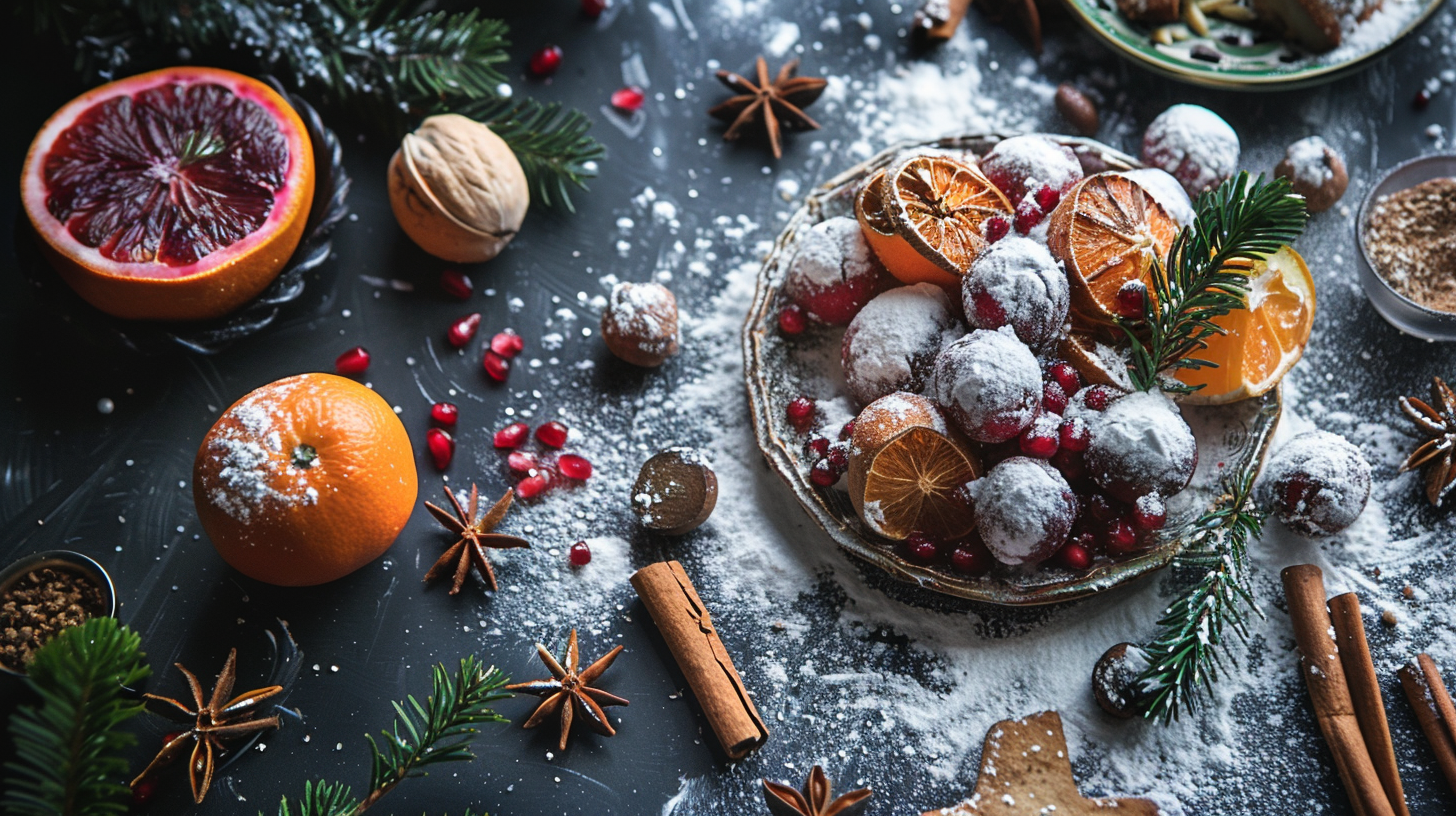Key points
• Lighting: Taking pictures of food in winter means you’ll often have less daylight. It’s important to get a handle on light sources; this could mean using artificial lights or making the most of the little sunlight we get. The main thing is to make sure the food looks good, showing off its textures and colors.
• Color Palette: The colors you’ll find in winter dishes are usually more muted – think earthy and dark, rich hues. Highlight these to give your photos a cozy and inviting feel, which is pretty much what winter food is all about.
• Props and Styling: To give your photos that winter feel, throw in some seasonal stuff like warm blankets, pine cones, candles, or even Christmas decorations. These bits and pieces help tell a story about the food that fits with the season.
Contents
- Key points
- Getting to Grips with Winter Food Photography’s Special Features
- Playing with Light and Shadows in Winter
- Winter Vibes in Colors and Surfaces
- Using Daylight Wisely When Days Are Short
- How to Use Fake Lights to Make a Warm Atmosphere
- Polishing Photos with Light Tricks
- Choosing Winter-Friendly Food and Ingredients
- Dressing Up for the Lens: Winter Textures and Shades
- Creating the Winter Feel in Photos
- Getting Ready for a Winter Food Photo Shoot
- Seasonal Projects for Building a Winter Food Portfolio
- Tips for Winter Photography
Getting to Grips with Winter Food Photography’s Special Features

Think about the winter scene; it’s full of special colors and stories. Every meal has its own tale, maybe pulled from old customs or the bold look of the cold months. When you take pictures, you’re trying to capture the strong, deep tastes that go hand-in-hand with winter food. You focus on the textures so much that they almost look warm just by seeing them.
Playing with Light and Shadows in Winter

In winter, it’s key to work with the mix of light and dark. The light in winter is usually gentler, coming in at a sharper angle, and it throws longer, bolder shadows. These can really make textures stand out and bring a bit of excitement to shots of food. You want to use this soft light to shape photos that seem vibrant and pull people in, making them feel like they’re sitting right there at the table.
Winter Vibes in Colors and Surfaces

Winter’s colors usually show up as subdued but rich. Picture dark reds, greens, pure whites, and the warm tones of freshly baked bread or golden pies. These colors provide a sense of balance as they reflect the season—icy berries, toasted nuts, hot drinks. Using these elements not only pleases the eye but also gives you an experience that goes beyond just looking nice.
Textures that pop bring life to this food-inspired dance. They outline details in dishes that might blend in if everything was the same color. For example, a photo might highlight the silkiness of chocolate topping next to the roughness of a spice cookie, all combining to evoke that cozy winter feeling we all love.
Using Daylight Wisely When Days Are Short

When winter arrives, the days get shorter and we all want more natural light. This is especially true for photographers who need to make the most of daylight to take beautiful pictures of food. The right light shows off the deep colors and textures of winter meals.
You can set up your photography space close to a window where the sun shines through softly, making your photos look smooth and avoiding sharp shadows. Also, think about scheduling your photo sessions for the golden hour—this is the time just after the sunrise or just before it sets when the sunlight has a magical, golden quality that makes everything look great.
How to Use Fake Lights to Make a Warm Atmosphere

After the sun sets, fake lights take over. By setting up these lights, you’re in charge of the mood and can fake the bright light of a winter’s day. Choose bulbs that have a cold bluish glow to simulate winter sun. You can reach for a softbox or LED panels if you want light spread out evenly.
Or try spotlights if you need to focus on certain parts of your food. Mixing up shadows and how bright the light is can give your scene layers and keep that chilly vibe no matter what time it is.
Polishing Photos with Light Tricks

Using reflection and diffusion is key to upgrade the vibe of pictures showing winter dishes. Reflectors help by adding light where it’s missing, smoothing out shadows, making sure everything looks even. If you go for white reflectors, you’ll get a gentle boost, but silver will make things pop more.
On the flip side, diffusers mellow down strong light so you don’t end up with sharp shadows or spots that are too bright—problems photographers know all too well. If you put a diffuser in front of your light and your subject, your photos will get a calm, soft touch, kinda like a gentle snowy day.
Choosing Winter-Friendly Food and Ingredients

Picking the right food for winter is key. Go for seasonal picks that fit the chilly vibe. Think root veggies, squash, and tough greens—they have winter written all over them. Meats like roast turkey, ham, and beef stew are perfect when it’s cold outside.
For sweets, you want something heavy, like chocolate fondue or a warm slice of apple pie to fight off the frost. Throwing in nuts, citrus fruits, and spices such as cinnamon and nutmeg will make sure everyone knows it’s winter on their plate.
Dressing Up for the Lens: Winter Textures and Shades

Getting dressed up for a photo means focusing on texture and winter colors. Mix in knits or rough wood elements to give your photos more depth. Use a color theme with white, blue, gray, and rich red to create a winter vibe.
Props are important too. Think about using things like pottery or heavy crockery to bring out a natural look in your setup. With the perfect arrangement, people can practically sense the snug feel of winter just by looking at your pictures.
Creating the Winter Feel in Photos

When you take pictures, aim to tell a winter story. Use the rule of thirds for a well-balanced photo and draw the viewer’s eye through the image. Place things like forks and decorations in a way that adds depth to your food shots.
For a peaceful winter mood, include some empty space in your pictures. This makes them calmer. Experiment with different angles and focus on certain parts to bring out the texture of your wintry meals, making them look more tempting.
Editing is key to capturing winter’s spirit in food photos. With some good edits, you can improve how a dish feels and virtually put viewers right into a cozy, wintry setting.
Adjusting Colors for the Perfect Winter Vibe
Color grading is super important for getting that winter feel. Change the colors to show off the season’s chill or set a specific mood. For example, adding blue shades and toning down other colors can make it feel colder. Go for warmer colors if you want to give off a snug vibe during cold times. Playing with these colors affects the emotional impact of your photos.
Bringing Out Winter Details in Editing
Textures are big in showing winter’s character – think about the crispness of snow or the roughness of sweaters. To highlight these textures, use sharpening in your edits. Making details pop like steam from soup or powdered sugar on cookies adds to the whole experience.
Using Editing Software for Winter Stories
Good use of editing software helps tell your winter tales spot on. Today’s software lets you do lots. Adjust lighting or add effects like snowy overlays or frost patterns to beef up your winter tale in food photos. But remember, don’t overdo it – keep it realistic and appealing.
Winter food photography has its own unique beauty and teaching moments. When we check out pro examples, we learn from their masterful use of light, color, and arrangement that truly reflects winter’s vibe.
How Pros Do Winter Food Photos
Looking at the pros, you notice how they nail the winter feeling in each shot. They mix the perfect light and colors with smart layouts to get that cool wintery atmosphere just right. Examining their work shows us how warm dishes against cold backgrounds can really make a photo stand out.
The Whole Process from Setup to Final Touches
To get those killer winter food pics, start with careful planning. Everything matters – choosing winter-like props, setting up the scene just so, and getting the lighting spot-on whether it’s natural or artificial to mimic those gloomy winter days. In post-production, tweaking things like contrast and color can take a photo from okay to amazing.
Tips from the Pros on Winter Scenes
Chatting with experts shines a light on their storytelling passion through food. They have tips for shooting that perfect steamy dish or capturing rich winter veggies’ colors. They stress taking your time and being exact, so every picture feels as comforting and warm as a winter meal should be.
Getting Ready for a Winter Food Photo Shoot

Good food photography in winter starts with a plan. Think about the story your photos will tell – maybe you’re highlighting a hot dinner or some fancy holiday snacks? Choose foods that scream winter in both taste and look.
It’s important to pick the right props, too. Things like pine cones or yuletide ornaments can really give off that winter feel. And don’t forget about the light – it’s usually softer in winter, giving your pictures a cool mood.
Seasonal Projects for Building a Winter Food Portfolio

Working on seasonal projects is a great way to spice up your portfolio and show off how adaptable you are as a photographer. Consider diving into different themes like classic holiday meals, dishes made with winter veggies or citrus fruits, and the kind of food that warms you up when it’s cold outside.
You could think about creating a series of pictures focused on warm drinks or pastries, which are staples of the winter season. Taking this route will not just broaden the range of your collection, but it’ll also keep you inspired as the seasons change.
Tips for Winter Photography

Capturing pictures in the winter can be tough, what with the harsh lighting and the cold. You’ve got less light during the day which means you need to really plan your time well. The cold isn’t just nippy on your fingers – it makes your camera batteries die faster, and your food props might start looking pretty sad if you’re out in the chill too long. So, here’s what you can do:
- Center your photo-taking schedule around when the light’s good, usually around noon in those frosty months.
- Keep a few extra batteries tucked away in your pockets to keep them cozy and working longer.
- If you’re going snap-happy outside, make it snappy to stop your food from looking uninviting.
- For indoor shoots where you want that cosy steamy look, try using a steamer or some warm water – but watch it doesn’t get too hot.
And hey, sometimes winter itself can give you some cool surprise effects in your pics, so go with the flow. Just make sure to take care of your equipment, and always have a Plan B just in case things don’t pan out as expected.

About Author
Rachel Noël is a professional photographer and videographer from the UK with over 10+ years of experience. Rachel specializes in Underwater, Tavel & Portrait photography among other areas.
